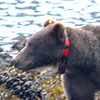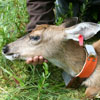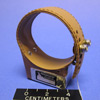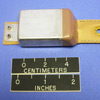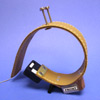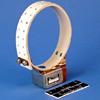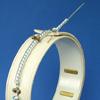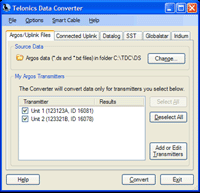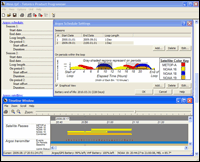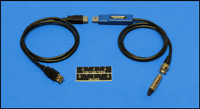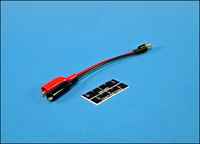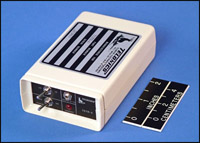GPS/Store on Board Terrestrial Systems
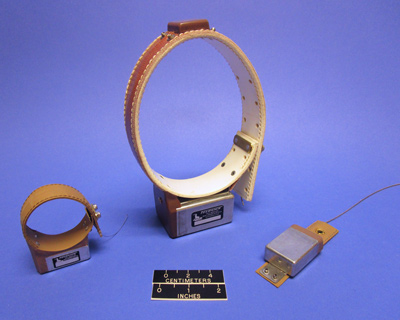
GPS Store-on-board models TGW-4000-4 and TGW-4500-5 on collars, and TGW-4100-4 on TPU tab for giant armadillo
Models
| Model |
Housing Dimensions
L x W x H (in, cm) |
Housing Weight (g) |
Weight with Collar (g) |
QFP Position Schedule |
Operational Life (years)
(VHF 10 hours/week) |
Operational Life (years)
(VHF 8 hours/day) |
| TGW-4000-4 | 1.8 x 0.9 x 0.8
4.7 x 2.4 x 2.0 | ~47 | ~67+ | 6/day | 1.3 | 0.6 |
| 12/day | 0.8 | 0.5 |
| TGW-4100-4 | 1.6 x 1.3 x 0.7
4.1 x 3.3 x 1.8 | ~60 | ~80+ | 12/day | 1.6 | 1.0 |
| 24/day | 0.9 | 0.7 |
| TGW-4105-4 | 1.9 x 1.3 x 0.7
4.9 x 3.3 x 1.8 | ~70 | ~90+ | 12/day | 2.4 | 1.4 |
| 24/day | 1.4 | 1.0 |
| TGW-4200-4 | 1.7 x 1.4 x 1.1
4.4 x 3.6 x 2.7 | ~115 | ~145+ | 24/day | 2.7 | 2.0 |
| 48/day | 1.5 | 1.2 |
Example operational life estimates for the above models assume temperatures of 10°C, VHF pulse period of 1500 msec (40 beats per minute), and use of QFP positions with an average time-to-fix of 15 seconds. Many other options are possible.
| Model |
Housing Dimensions
L x W x H (in, cm) |
Housing Weight (g) |
Weight with Collar (g) |
GPS/QFP Position Schedule |
Operational Life (years) with standard GPS positions |
Operational Life (years) with QFP positions |
| TGW-4400-5 | 2.5 x 1.8 x 1.4
6.5 x 4.6 x 3.6 | 210 | ~350-650 | 12/day | 2.9 | 4.5 |
| 24/day | 2.0 | 3.9 |
| TGW-4500-5 | 2.8 x 2.0 x 1.5
7.3 x 5.1 x 3.7 | 340 | ~500-830 | 24/day | 4.2 | 8.2 |
| 48/day | 2.6 | 6.6 |
| TGW-4600-5 | 3.5 x 2.7 x 2.3
8.9 x 6.9 x 5.9 | 625 | ~900-1500 | 48/day | 4.9 | 11.8 |
| 96/day | 2.8 | 8.7 |
| TGW-4700-5 | 4.5 x 2.7 x 2.3
11.5 x 6.9 x 5.9 | 875 | ~1150-2000 | 48/day | 7.0 | 15.8 |
| 96/day | 4.1 | 12.0 |
Example operational life estimates for the above models assume temperatures of 0°C, VHF operating 8 hours/day with a pulse period of 1500 msec (40 beats per minute), and use of either QFP positions with an average time-to-fix of 15 seconds or GPS with an average time to fix of 75 seconds. Many other options are possible.
Replaceable Battery Store on Board Model for enclosure studies and short term field deployments
| Model |
Housing Dimensions
L x W x H (in, cm) |
Housing Weight (g) |
Weight with Collar (g) |
GPS/QFP Position Schedule |
Operational Life (years) with standard GPS positions |
Operational Life (years) with QFP positions |
| TGWR-4500-5 | 3.0 x 2.0 x 1.5
7.6 x 5.1 x 3.7 | 260 | ~450-830 | 24/day | 4.2 | 8.2 |
| 48/day | 2.6 | 6.6 |
Example operational life estimates for the TGWR-4500-5 assumes temperatures of 0°C, VHF operating 8 hours/day with a pulse period of 1500 msec (40 beats per minute), and use of either QFP positions with an average time-to-fix of 15 seconds or GPS with an average time to fix of 75 seconds. Many other options are possible.
Key Features
- All positions determined and sensor data collected is stored-on-board the unit, but not transmitted.
- In addition to the GPS portion of these models, they include a VHF transmitter, which can be used to locate or monitor the animals from the ground or aircraft, and aid in recovery of the unit at the end of a study.
- These models can include mortality, activity, and temperature sensors.
- Telonics QFP positioning can be incorporated into these collars. QFP is Telonics quick fix positioning technology that obtains the data necessary to calculate a GPS position in as little as 2-5 seconds. This allows positions to be determined much more quickly and with less energy expenditure than a standard GPS position. Units can be configured to collect GPS, QFP, or a mix of the two location types.
- All these models are fully-hermetically sealed for maximum reliability, with the transmitter, battery, and interconnects sealed into a single metal housing. This is the same technology used by NASA for maintaining high performance electronics in harsh environments. With hermetic packaging, there is no problem with moisture penetration even after years of deployment, except in cases of severe physical damage to the canister. No polymeric packaging offers this level of reliability.
- These models can be provided with the GPS antenna end-mounted on the housing (thus side-looking under the animal’s neck) or dorsally-mounted on the collar. Side-mounting is the most durable; dorsal mounts can provide improved GPS connectivity. Dorsally-mounted antennas add somewhat to the weights listed.
- Telonics CR-5 or CR-7 programmable collar release mechanisms can be added to collars of appropriate size (the CR-5 requires at least a 2-inch wide collar and the CR-7 requires at least a 1.5-inch wide collar).
- Users can program or reprogram these units through use of Telonics Product Programmer (TPP). TPP can be used to obtain estimates of battery life.
- GPS/QFP collection schedules, VHF schedules, and sensor options can all be user-defined. Scheduling can be programmed to change over time (e.g. seasonal changes where monitoring might be more or less intensive at certain times of the year).
- Data downloaded from a collar in hand are processed using Telonics Data Converter (TDC).
- A real-time clock and calendar controls all timing functions and is re-synchronized with GPS time to assure high accuracy timing. All timing is programmed using Coordinated Universal Time (UTC).
- When turned off using a magnetic switch, these units consume less than 10 µA; this allows storage for extended periods with minimal impact on operational life.
- Units can be refurbished to their original condition at Telonics.
Electronic Specifications
GPS/VHF Specifications - Show
General Specifications
| Timing Accuracy |
Timing is synchronized to GPS time when available. If GPS time is not available, then internal timing accuracy is:
6 min/year at 25° C
30 min/yr -20 to +40° C
47 min/yr -40 to +70° C |
| Available Sensors |
Mortality, Activity, Temperature, Low Voltage (as allowed by specific software)
Salt-water-switch and Pressure are hardware and software options on some configurations. |
| Memory Capacity |
Capable of storing ~500K fixes in nonvolatile flash memory in association with other sensor data. |
| Programming |
Programmable using Telonics TPP software and TSC-9A cable. Programming options are hardware and software dependent, but include GPS, Argos, and VHF schedules; sensor activation and schedules; power output; Argos can also be scheduled to transmit only during satellite overpasses based on the GPS location and the orbital parameters installed prior to deployment. |
GPS Receiver Specifications (-5 models)
| Performance |
-167 dBm tracking sensitivity
-148 dBm acquisition sensitivity |
| Datum |
WGS-84 |
| Time to First Fix (TTFF) |
30 seconds typical (with clear view of sky)
Quick Fix Pseudoranging (QFP) 2-5 seconds typical (with clear view of sky) |
GPS Receiver Specifications (-4 models and older)
| Performance |
-163 dBm tracking sensitivity
-147 dBm acquisition sensitivity |
| Datum |
WGS-84 |
| Time to First Fix (TTFF) |
35 sec typical (with clear view of sky)
Quick Fix Pseudoranging (QFP) 3-5 sec typical (with clear view of sky) |
VHF Transmitter Specifications
| Available Frequency Options |
Option 700 138-175 MHz
Option 720 210-240 MHz
Note: Frequency can be programmed in 100Hz steps within a given frequency range. |
| Frequency Stability |
Better than ±3ppm at room temperature ±5 ppm total tolerance over full temperature range |
| Operating Temperature |
-40° to +70° C |
| Pulse Width |
Programmable (10 to 250 msec) |
| Pulse Period |
Programmable (265 to 5000 msec)
Multiple pulse periods selectable per specific software and TPP |
| Transmitter Timing |
Programmable, including daily and seasonal duty cycles. |
| Power Output |
Selectable levels via hardware and software.
Effective Isotropic Radiated Power (EIRP) varies, depending on packaging, antenna configuration, and immediate environmental conditions. *California Users: This transmitter meets the California requirement of EIRP < 0.0009W for all configurations. |
| Emission Designator |
2k00P0N |
| Harmonic Suppression |
Better than 30dB (>40 dB typical) |
| Spurious Emissions |
<-35 dBc at 10 kHz offset from carrier |
| Frequency |
Aging: <2ppm/year
Shock: <1ppm 3000g x 0.3ms x ½ sine x 3 dir |
| VSWR |
RF output stable to 10:1 VSWR, all phases
Radiated harmonic levels are degraded with poor load VSWR.
Spurious emission specification maintained for >10:1 VSWR |
Photo Gallery
Manual
Related Products
Legacy Products
This information on discontinued products is provided for individuals who are still using these older systems. Product descriptions may be time sensitive or even outdated. Please contact Telonics if you have questions.
Telonics supports these products as possible based on availability of parts, software, or other considerations; but no longer sells them new.
The following subsystems are obsolete and are not available to be refurbished:
Lithium Battery Shipping Regulations
Telonics Inc. ships all systems containing lithium batteries in accordance with the US Department of Transportation rules for hazardous materials set forth in 49CFR and the IATA Dangerous Goods Regulations.
Shipping dangerous goods can be complicated and confusing, consult a dangerous goods specialist if needed. The general requirements for shipping lithium batteries according to 49CFR are located in Part 173, Subpart 173.185 in the link below.
http://www.ecfr.gov/cgi-bin/text-idx?SID=e8334217c2c8d081457a5156872ad037&tpl=/ecfrbrowse/Title49/49cfrv2_02.tpl#0
Service Commitment
Since 1970, Telonics has built a reputation based on product quality, product support, service, and customer satisfaction. Telonics strives to produce the highest quality products, and to support those products accordingly.
Because of extreme conditions and the unpredictable nature associated with most telemetry applications, problems occasionally arise. Most problems can be resolved quickly. In all cases, we hope to be able to work in partnership with users to resolve problems to the user's satisfaction and to uphold our demonstrated commitment to excellence. If problems should arise, all products must be returned to our factory for failure analysis.
Warranty: GEN 4 GPS Systems - Show
Telonics warrants its GPS products to be free from defects in material and workmanship for a period of one year from the date acquired. Telonics does not warrant batteries.
Telonics designs and manufactures systems for a variety of applications using several satellite systems (GPS, Argos, Iridium, and Globalstar). At the time of manufacturing, Telonics equipment is tested to verify compatibility with the applicable satellite system(s). Telonics does not warranty equipment against changes in satellite system specifications or satellite operation after the date your equipment was manufactured. Unforeseeable or unplanned system changes would include, but are not limited to, elevated ambient noise levels in the radio frequency bands used for satellite communications, elimination of service in a region of the world, data outages due to technical problems within the satellite system network, or reductions in data transfer capability due to alterations in the constellation as a result of premature space vehicle failures or failure to replace space vehicles in a timely manner.
If a defect occurs, return the equipment to us within the proper time frame at the following address: TELONICS, 932 E. IMPALA AVENUE, MESA AZ USA 85204-6699. The customer shall arrange for and pay all shipping, insurance and related charges incurred in the shipment to and from Telonics under this warranty. Damage to any equipment resulting from misuse, accidents, unauthorized service, extreme conditions, or other causes, is excluded from this warranty. Telonics does not assume responsibility for loss or damage to equipment during shipment. Telonics does not assume responsibility for delays resulting from shipment on commercial or private carriers. We insure all equipment shipped from our facility and suggest that shipments to Telonics also be insured.
Upon the timely return to our facility, if defective, the product will be replaced or repaired at our discretion at no cost to the customer. This remedy is the exclusive remedy. This product is supplied without any further warranties or conditions, expressed or implied, including warranties of merchantability, quality or fitness for particular reason or those arising by laws, statutes or trade usage or course of dealing.
The entire risk, as to the results and performance of the product, is assumed by the customer. Neither Telonics, nor its suppliers, shall have any liability to the customer or any other person or entity for any indirect, incidental, special, or consequential damage whatsoever, regardless whether Telonics has been told of the possibility of such damages or that such damages might be foreseeable. Telonics has no responsibility or liability for the claims of any third party. The maximum aggregate to the customer, of Telonics and its suppliers, shall not exceed the amount paid by the customer for the product.


